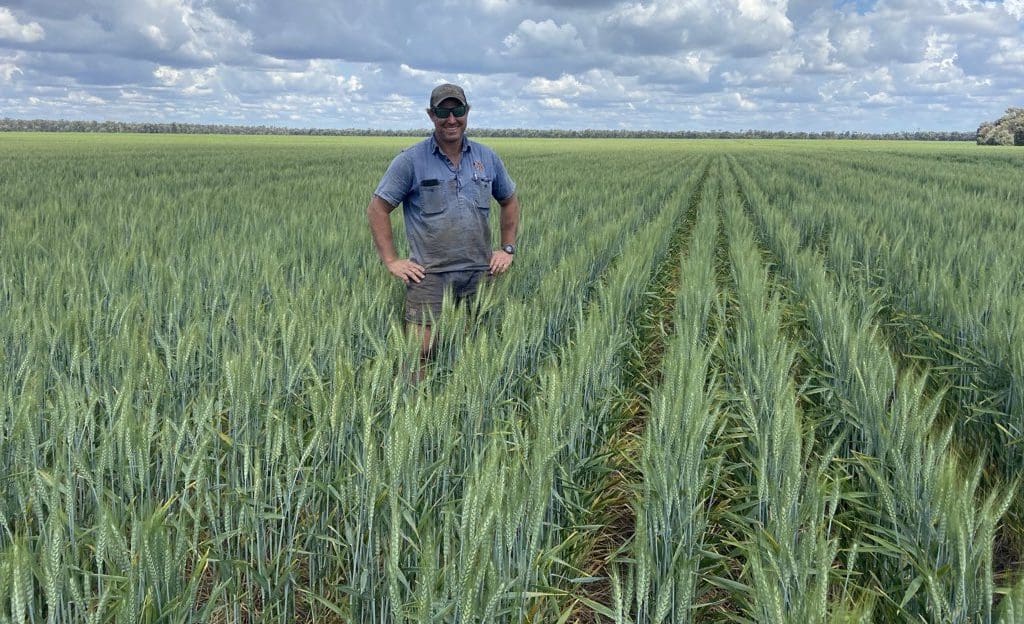
Condamine grower Chris Cook in a crop of Valiant CL Plus wheat which will be harvested next month on Queensland’s Western Downs. Photo: Matt Naumann, InterGrain
SPRING is already wet across the entire Australian grainbelt, and is forecast to get wetter in coming weeks.
As yield prospects improve on late-season rain, protein in wheat is looking like it will be hard to find, and the southern market’s only significant move this week has been a nominal $10-per-tonne upgrade for ASW, the lowest-protein milling wheat. in northern markets gains of $10/t were also quoted in barley new crop delivered Darling Downs.
A National Day of Mourning has been declared for September 22 to commemorate the life of Queen Elizabeth II.
In Victoria, this will precede the AFL Grand Final holiday, and trade sources say forecast rain, plus next week’s public holidays, have a few loads being sought in an otherwise flat market.
| Prompt | Sep 8 | New-crop | Sep 8 | |
| Barley Downs | $370 | $370 | $365 | $355 |
| SFW wheat Downs | $380 | $385 | $370 | $370 |
| Sorghum Downs | $362 | $355 | $355 | $350 |
| Barley Melbourne | $370 | $363 | $360 | $360 |
| ASW Melbourne | $408 | $405 | $425 | $415 |
| SFW Melbourne | $385 | $380 | $408 | nq |
Table 1: Indicative prices in Australian dollars per tonne.
In the past week, some parts of eastern and South Australia’s grain-growing areas had no rain, but most had 15-50 millimetres, while Western Australia got a maximum 15mm.
Parts of NSW are excessively wet, and experiencing minor flooding. Registrations in the week to 9am today include: Dubbo 48mm; Grenfell 57mm; Peak Hill 48mm; Moree 25mm; Temora 42mm; West Wyalong 38mm.
Queensland’s earliest wheat crops are on the verge of harvest, and patchy rain will delay ripening.
In Central Queensland, registrations include: Clermont 13mm; Emerald 32mm; and Springsure 12mm.
Southern Queensland falls include: Dalby 17mm; Hannaford 47mm; Macalister 19mm, Roma 27mm, and Surat 69mm.
North trades sideways
Consumers in northern markets are seen as well covered on barley and SFW wheat, with feedlots on Queensland’s Downs drawing increased amounts from south of the border as old-crop stocks run low.
“A lot of what we’re seeing now is coming from around Moree and Narrabri.”
Broun & Co director Charles Coventry said consumers have more coverage now than they normally would in the lead-up to harvest, and are mostly out of the market.
“It’s remarkably quiet,” Mr Coventry said.
“The falling market has meant a huge amount of cover already taken.”
Indicative prices quoted on Grain Central show the market for barley and SFW wheat delivered Downs is now $120-$130/t below its highs seen mid-May and fuelled by global concerns, especially the war in Ukraine, and limited selling from Australian growers.
“The consumer end of the market is starting to feel a little more optimistic.
“Growers’ attention was on planting, not selling; growers are getting a little shell shocked now with the prices on offer.”
Mr Coventry said big stocks of wheat in NSW’s western growing areas were evident, and its distance to port and major consumption hubs made it less sought-after by the market.
“There are challenges with old-crop carry-out in central and western NSW; it’s the cost of executing.”
Industry consensus is that NSW SFW-type wheat stocks would be considerably lower if flooding and associated rain damage had not had such a big impact on the rail network which feeds NSW bulk export terminals.
“The reason for the carry-out of wheat is partly rail efficiencies, and the Great Dividing Range.
“Growers have got a right to be cranky with rail; we do have port capacity in NSW, and right now we need it.”
South’s protein premium grows
Most of Victoria’s cropping regions had 20-40mm rain for the week, and South Australian registrations where largely in the 10-50mm range.
A further 10-50mm is forecasts for the coming week from southern Queensland to South Australia, and is challenging the protein outlook for early wheat crops which will start to hit the bins from late next month.
In Victoria, Rex James Stockfeed commodity manager Tim Hogarth said the likelihood of a big low-protein year was already affecting grade spreads, and demand for milling wheat was already evident.
“That will go through the next 12 months.
“Typically we see the spread from APW to ASW at $12-$15/t; now it’s more like $40.”
Apart from red wheats developed for the feed market, Victoria is believed to have produced very little feed-grade white wheat from the last harvest.
Mr Hogarth said barley has become the hard-to-place grain, possibly reflecting the dry-up in accumulation for export shipments.
“Growers still have tonnes to sell, but the appetite of buyers isn’t what it was.”
“A lot of end users have probably got the cover they need.”
“The market’s pretty flat, and options to execute are limited.”
“People are trying to clear out silos; we’re seeing offers of 40t here and 40t there, and “I’m still seeing grainbags in paddocks.”
Grain Central: Get our free news straight to your inbox – Click here

HAVE YOUR SAY